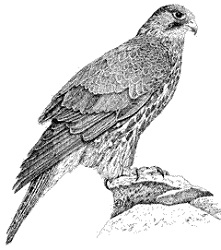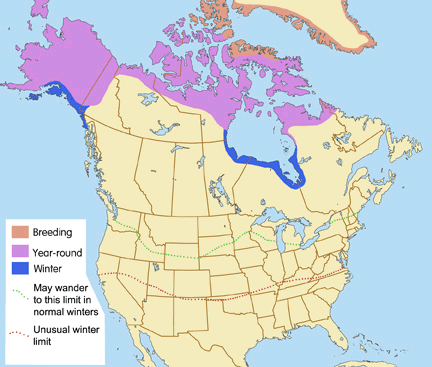
Scientific Name: Falco rusticolus
The Gyrfalcon is the largest of all falcons, with females substantially larger than males. They are the most northern of the diurnal raptors. Like other falcons, they have dark eyes, and a short, strong beak with a tomial tooth used for killing prey. Their bodies are streamlined, hard and compact with smallish heads and long pointed wings. As with other bird-catching raptors, their toes are long and thin. There is no sexual color dimorphism in this species but individuals do vary greatly in color, from pure white to uniform dark gray-brown. Tail may be barred or unbarred. The Gyrfalcon is distinguished from the Peregrine Falcon (Falco peregrinus) by the lack of a dark cap and a crown and/or nape that is heavily streaked. The Gyrfalcon also has a shorter, broader wing base with a rounder wing tip than does the Peregrine. The flight of the Gyrfalcon is more buoyant, and they are capable of more sustained flight, but are less maneuverable than the Peregrine.
Male
Length: 19 – 24″ ave.
Wingspan: 27 – 30″
Weight: 1.7 – 3.0 lb.
Female
Length: 20 – 25″ ave.
Wingspan: 27 – 32″
Weight: 3.0 – 4.5 lb.
The Gyrfalcon is both federally and state protected under the Migratory Bird Treaty Act but has no special listing status in the United States. They have been less effected by DDT and other pesticides than the Peregrine Falcon, due to their being resident (mostly non-migratory) in remote locations with low pesticide usage and feeding on non-migratory birds, which do not carry as much pesticide contamination (e.g., ptarmigan or seabirds). In some parts of the world they are threatened by the falconry trade. Habitat loss is not a current issue for this species due to the remoteness of their habitat.
Arctic and alpine tundra above the boreal forests, often along rivers or seacoast, are the primary breeding location of this species. Little migration occurs after the breeding season, however higher latitudes and elevations are probably vacated during the winter. In more temperate regions, open areas at lower elevations are chosen as habitat. These falcons will concentrate in areas where prey congregate such as seacoasts, reservoirs, and agricultural areas. Terrain is usually flat or rolling with little forest cover.
Diet consists of many bird species but the principle food is ptarmigan. Some mammals are also taken as prey, mostly by individuals at higher latitudes and elevations. Prey population numbers will strongly influence breeding success and population density of Gyrfalcons. These falcons will hunt with short stoops, knocking or driving prey to the ground. They will often pursue their prey for long distances (tail chases) until the prey tires and is knocked to the ground. Prey is less likely to be grabbed from the air as it is to be knocked to the ground and taken. Gyrfalcons are opportunistic hunters, taking the easily seen displaying male ptarmigans during breeding season even when ptarmigan numbers are not larger than other potential prey species.
Similar to other Falco species with a series of Kak sounds repeated in relatively short intervals.
Males begin defending nesting territory in mid-winter (end of January) while females arrive near the beginning of March. After approximately 6 weeks of pair bonding, eggs are laid at the end of April. This species does not build nests, though when stick nests of other predatory birds are available, they will be used. Nests are typically found on cliff ledges when pairs are nesting above the tree line. These nests are easily seen from the yearly build-up of guano. Eggs can be laid on bare soil. Nest sites are chosen by their relative closeness to colonial-nesting seabirds or waterfowl. A single brood can vary greatly in color, and it is not certain what genetically controls color variation in individuals. Prey is delivered throughout the day during the nesting season, with the prey decapitated and plucked at the kill site rather than the nest. Females will cache the food in nearby vegetation to feed to the chicks as their food requirements increase. At around 10 days the heavily downed chicks are able to thermo-regulate and will be left by the female so she can begin foraging with the male.
These birds do not come into rehabilitation very often, due to their remote range. When they are found near people, the most common injuries are from collisions with motor vehicles.

Circumpolar arctic and sub-arctic tundra, near colonial-nesting seabirds and waterfowl, often along rivers and seacoast. Some movement south in fall and winter by younger birds, particularly immature females – they are primarily following prey birds. In North America, adult birds are found below 70N and remain residents throughout the year. Movements of this species are highly dependent on food availability.
Special Thanks for range maps:
Dan Gleason
BGleason Design & Illustration
Commercial & Scientific Illustration, Graphic Design
CraneDance Communications
Book Production/Design

